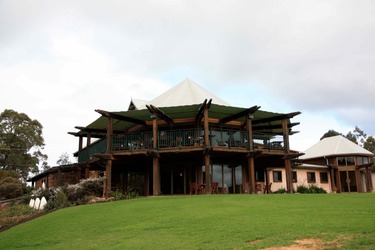By this time the sun was well and truly over the yard arm and lunch beckoned, so the next stop was Hay Shed Hill, which rated a visit for a couple of reasons. For a start, their cafe-deli looked like an excellent lunch option, and we'd received a non-Halliday recommendation from a knowledgeable source (thanks, Helen!).
The Cellar Door, under the supervision of a gentleman of northern European extraction and an accent that may or may not have been German, was an impressive operation, and the samples were administered with an almost Teutonic efficiency. We broke about halfway through for lunch, returning to be seamlessly reintegrated into the tasting cycle. As indicated, highly impressive. The wines, on the other hand, were a more mixed bag. For a start, despite the efficiency behind the counter, I found myself zipping around the order form as I worked my way through the four separate ranges on offer.
The entry level wines in the Pitchfork range ($17, case price $15) were solid without demanding attention, except for the 2009 Pitchfork Pink, a Rose style on special at $10 by the case, ideal summer drinking and there's a dozen sitting in the wine rack as I type. The next step up, the Hay Shed Hill Vineyard Series, were consistently around 4/5, with the exception of the 2008 Cabernet Merlot, an easy drinking style that was pleasant enough but which I thought was a touch on the light side (3.5/5 $20, case price $18)) and the 2008 Cabernet Sauvignon (5/5 $25/$22)) a classy line that comes out of the glass right into the nose and came through very nicely rounded on the palate and the 2009 Botrytis Riesling (5/5 $22/$29) which my tasting notes label, quite simply. as sublime. In between, the 2009 Sauvignon Blanc Semillon, 2009 Chardonnay and 2008 Shiraz Tempranillo (interesting blend) all rated a solid 4/5 at $20/$18.
Next up the pecking order, the World Series Wines ($30/$25), a Tempranillo and a Sangiovese from 2008 were interesting explorations of two newer varietals, and I must say I preferred the Sangiovese, a pleasant savoury style.
The top of the range Block Series were a definite step up, with the 2009 Block 6 Chardonnay (4.5/5 $35/$30) a highly perfumed new style Oz style, the 2008 Block 8 Cabernet Franc (4/5 $35/$30) having varietal character to burn in a medium-bodied style and the dry with depth 2005 Block 10 Petit Verdot (4.5/5 $35/$30) also rating pretty highly. To finish, the 2008 Block 2 Cabernet Sauvignon ( 4.5/5 $50/$45) was quite outstanding (95 from Halliday). Overall, looking back on it, while I escaped from the winery with credit card dockets for dozens of the Pitchfork Pink and a cleanskin 2008 Merlot that was quite acceptable drinking @ $8 I don't know that there'll be a great deal of ordering action headed back towards Hay Shed Hill.
 The curse of the missing tasting notes kicked in at the next stop, Ashbrook Estate, where we met another friendly and informative cellar door attendant, but with the only evidence to hand being a single sheet totally bereft of scribbled comments I've got very little option but to move straight on to Vasse Felix, one of the Margaret River icons that I was particularly looking forward to.
The curse of the missing tasting notes kicked in at the next stop, Ashbrook Estate, where we met another friendly and informative cellar door attendant, but with the only evidence to hand being a single sheet totally bereft of scribbled comments I've got very little option but to move straight on to Vasse Felix, one of the Margaret River icons that I was particularly looking forward to.
You never quite know what's in store when you pull into the visitors' car park at any time, but the last stop of the day can be problematic. Looking back on two days in Margaret River I've got to admit that both last visits were not quite underwhelming, but weren't as impressive as they could have been.
Everything I tried at Vasse Felix was in the 3.5 to 4 range on Hughesy's five point scale, and the two Heytesburys (the Chardonnay and the Cabernet/Malbec/Petit Verdot) lived right up to their reputations, price points and 96-point Halliday ratings. The 2009 Chardonnay (4/5) was another classy new breed Oz Chard, though I'm not sure I'd be shelling out $27 (Cellar Club $21.60), while the 2009 Semillon (4/5 $25/$20) was a nice expression of the variety. Bit of oak lurking in the background, fragrant bouquet and quite delicious. You could say much the same about the Sauvignon Blanc Semillon ($25/$20), balanced with the obligatory tropical fruits on the nose and across the palate. The 2010 Classic Dry White ($20/$16) had an awfully familiar nose, and I rated it as another 4/5 while the 2009 Viognier ($25/$20) was better than most I've tried though I'm still not totally convinced.